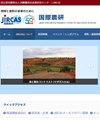Effects of Forage Corn Silage Preparation on Early-instar Larval Survivability and Egg Hatchability of Fall Armyworms (<i>Spodoptera frugiperda</i>)
IF 0.5
4区 农林科学
Q4 AGRICULTURE, MULTIDISCIPLINARY
引用次数: 0
Abstract
In this study, we investigated the effects of laboratory-scale silage preparation using a plastic bag and incubation on the early-instar larval viability and egg hatchability of fall armyworms (FAWs) inoculated into corn. In experiments performed to evaluate the effects on larval viability, the impacts of vacuum and anaerobic conditions were assessed as factors expected to influence larval viability after silage preparation. In the experiment that evaluated the effects on egg hatchability, the effects of enclosed fresh corn or fermented corn silage were examined. In the experiment that evaluated the effects of vacuum during silage preparation, no viable larvae were detected in anaerobic conditions, regardless of the length of incubation time (24 h or 14 days). In the experiment that confirmed the effects of carbon dioxide (CO2) gas during silage preparation, no viable larvae were noted under enclosed CO2 conditions, regardless of the incubation period (24 h or 14 days). After 3 days of silage preparation, we also found that egg hatchability was 0.05%. These results suggest that forage corn contaminated with FAW has a reduced larval viability rate and egg hatchability in the early stages of silage preparation, suggesting a low chance of FAW spreading from corn silage prepared under airtight conditions.饲用玉米青贮对秋粘虫(<i>Spodoptera frugiperda</i>)早期幼虫存活率和卵孵化率的影响
本研究研究了实验室规模的袋装青贮和孵育对接种玉米的秋粘虫(FAWs)早期幼虫活力和卵孵化率的影响。在青贮后影响幼虫活力的试验中,真空和厌氧条件作为影响青贮后幼虫活力的因素进行了评估。在评价青贮对鸡蛋孵化率影响的试验中,考察了封闭新鲜玉米和发酵玉米青贮对鸡蛋孵化率的影响。在青贮准备过程中真空影响的试验中,无论孵育时间(24 h或14 d)的长短,在厌氧条件下均未检测到活仔鱼。在证实二氧化碳(CO2)气体在青贮准备过程中的作用的实验中,无论孵育时间是24 h还是14 d,在封闭的CO2条件下都没有发现活仔鱼。青贮准备3 d后,鸡蛋孵化率为0.05%。综上所示,在青贮前期,饲用玉米受FAW污染后,其幼虫存活率和卵孵化率均降低,说明在密闭条件下制备的青贮玉米中FAW的传播几率较低。
本文章由计算机程序翻译,如有差异,请以英文原文为准。
求助全文
约1分钟内获得全文
求助全文
来源期刊
CiteScore
1.00
自引率
25.00%
发文量
42
审稿时长
>36 weeks
期刊介绍:
The Japan Agricultural Research Quarterly (JARQ) is a publication of the Japan International Research Center for Agricultural Sciences (JIRCAS), which provides readers overseas with the latest information on key achievements and developments in agricultural research in Japan, with the expectation that this information would contribute to the agricultural development of countries in tropical and subtropical regions.

 求助内容:
求助内容: 应助结果提醒方式:
应助结果提醒方式:


